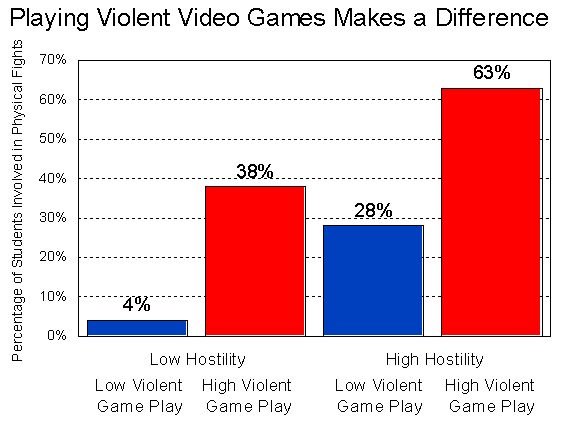Some critics believe video game violence to be a more potent factor in promoting aggression because of the level of interactivity involved. Unlike television or movies, where viewers are passive and unable to direct the content of what they are viewing, video game play allows for a level of controllability not seen in other media. Players are given control over where their characters move, what actions they choose to engage in, and even what their goals are. As a result, game play requires active concentration and physical and mental activity (Renzetti, 2008, p. 747).
I think that this source is more important to understanding other scholarly sources, and was important to include in my research because it laid a good foundation upon which the other resources could build on.
The second source I found captivating was a journal article in the Journal of Experimental, titled, "The effect of video game violence on physiological desensitization to real-life violence". This study was conducted by three researchers, who sought to discover if there was a relationship between , "violent video game effects on physiological desensitization, defined as showing less physiological arousal to violence in the real world after exposure to video game violence in the virtual world" (Carnagey, 2007). The study found that exposure to video game violence, "It appears that individuals who play violent video games habituate or 'get used to' all the violence and eventually become physiologically numb to it" (Carnagey, 2007).
Published in 2011, the article titled, "The effect of violent video games on aggression: Is it more than just the violence?"directly investigated the research question posed by this research project. By addressing the limitations in measuring violence in video games, authors Paul J.C. Adachi and Teena Willoughby conclude through various experiments that violence in video games does lead to aggressive behavior. They explain:
Therefore, the fact that many adolescents play violent video games for several hours every day clearly stresses the need for a greater understanding of the effects of violent video games on aggression. It is not until game characteristics are held constant and an unambiguous measure of aggressive behavior is used that the influence of violent content on aggression can be assessed.
My final source, "Violent Video Games: Specific Effects of Violent Content on Aggressive Thoughts and Behavior" found similar results to the previous source:
This study also provided the first correlational support for the contention that such long-term effects on aggressive behavior are mediated by persistent aggressive thoughts, here indexed by two different attitudes toward violence measures. Furthermore, this study provided the first correlational evidence that the violent video game exposure link to aggression persists even when a host of basic personality factors are statistically controlled.
Works Cited:
Craig A. Anderson, Nicholas L. Carnagey, Mindy Flanagan, Arlin J. Benjamin Jr., Janie Eubanks, Jeffery C. Valentine, Violent Video Games: Specific Effects of Violent Content on Aggressive Thoughts and Behavior, Advances in Experimental Social Psychology, Academic Press, 2004, Volume 36, Pages 199-249, ISSN 0065-2601, ISBN 9780120152360, 10.1016/S0065-2601(04)36004-1.
(http://www.sciencedirect.com/science/article/pii/S0065260104360041)
Nicholas L. Carnagey, Craig A. Anderson, Brad J. Bushman, Erratum to “The effect of video game violence on physiological desensitization to real-life violence” [J. Exp. Social Psychol. 43 (2007) 489–496], Journal of Experimental Social Psychology, Volume 43, Issue 4, July 2007, Page 684, ISSN 0022-1031, 10.1016/j.jesp.2007.04.007. (http://www.sciencedirect.com/science/article/pii/S0022103107000650)
Paul J.C. Adachi, Teena Willoughby, The effect of violent video games on aggression: Is it more than just the violence?, Aggression and Violent Behavior, Volume 16, Issue 1, January–February 2011, Pages 55-62, ISSN 1359-1789, 10.1016/j.avb.2010.12.002. (http://www.sciencedirect.com/science/article/pii/S135917891000073X) Keywords: Violent video games; Aggressive behavior; Competitiveness; Violence
Renzetti, C. M. (2008-01-01). Video Games, Violence Exposure in. Encyclopedia of interpersonal violence (pp. 744-747). Sage Publications, Inc.
Nicholas L. Carnagey, Craig A. Anderson, Brad J. Bushman, Erratum to “The effect of video game violence on physiological desensitization to real-life violence” [J. Exp. Social Psychol. 43 (2007) 489–496], Journal of Experimental Social Psychology, Volume 43, Issue 4, July 2007, Page 684, ISSN 0022-1031, 10.1016/j.jesp.2007.04.007. (http://www.sciencedirect.com/science/article/pii/S0022103107000650)
Paul J.C. Adachi, Teena Willoughby, The effect of violent video games on aggression: Is it more than just the violence?, Aggression and Violent Behavior, Volume 16, Issue 1, January–February 2011, Pages 55-62, ISSN 1359-1789, 10.1016/j.avb.2010.12.002. (http://www.sciencedirect.com/science/article/pii/S135917891000073X) Keywords: Violent video games; Aggressive behavior; Competitiveness; Violence
Renzetti, C. M. (2008-01-01). Video Games, Violence Exposure in. Encyclopedia of interpersonal violence (pp. 744-747). Sage Publications, Inc.

